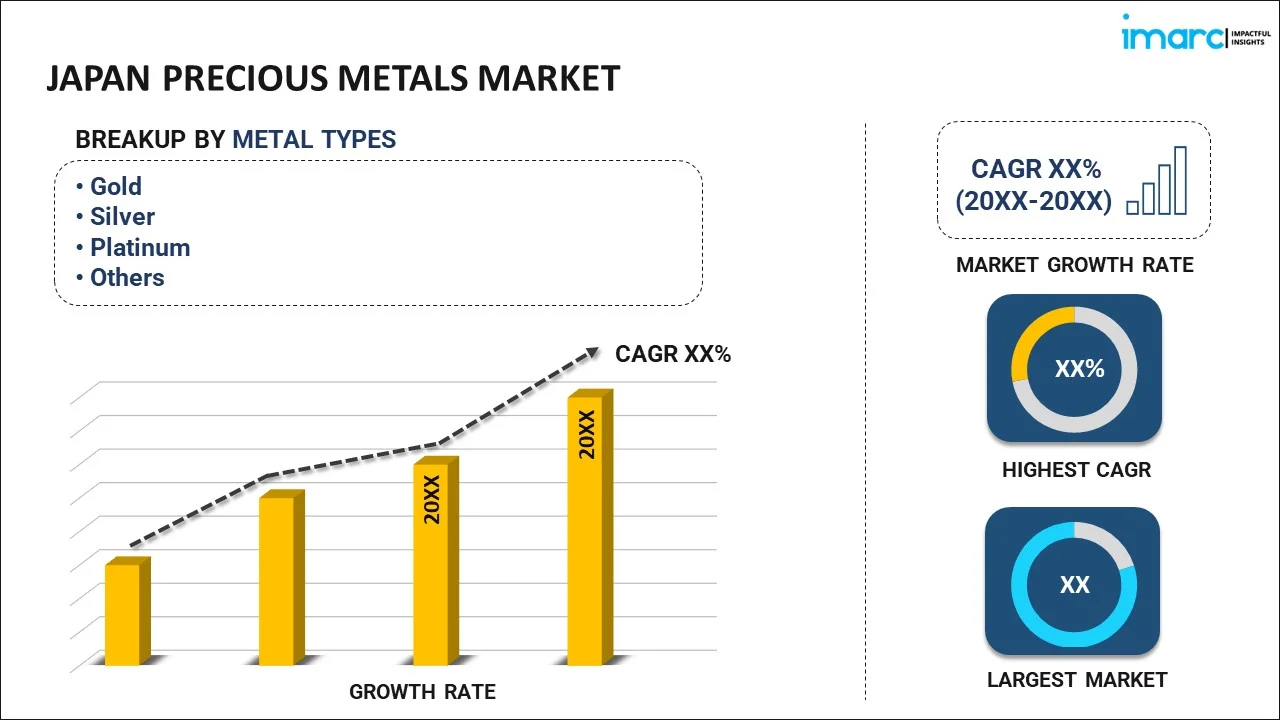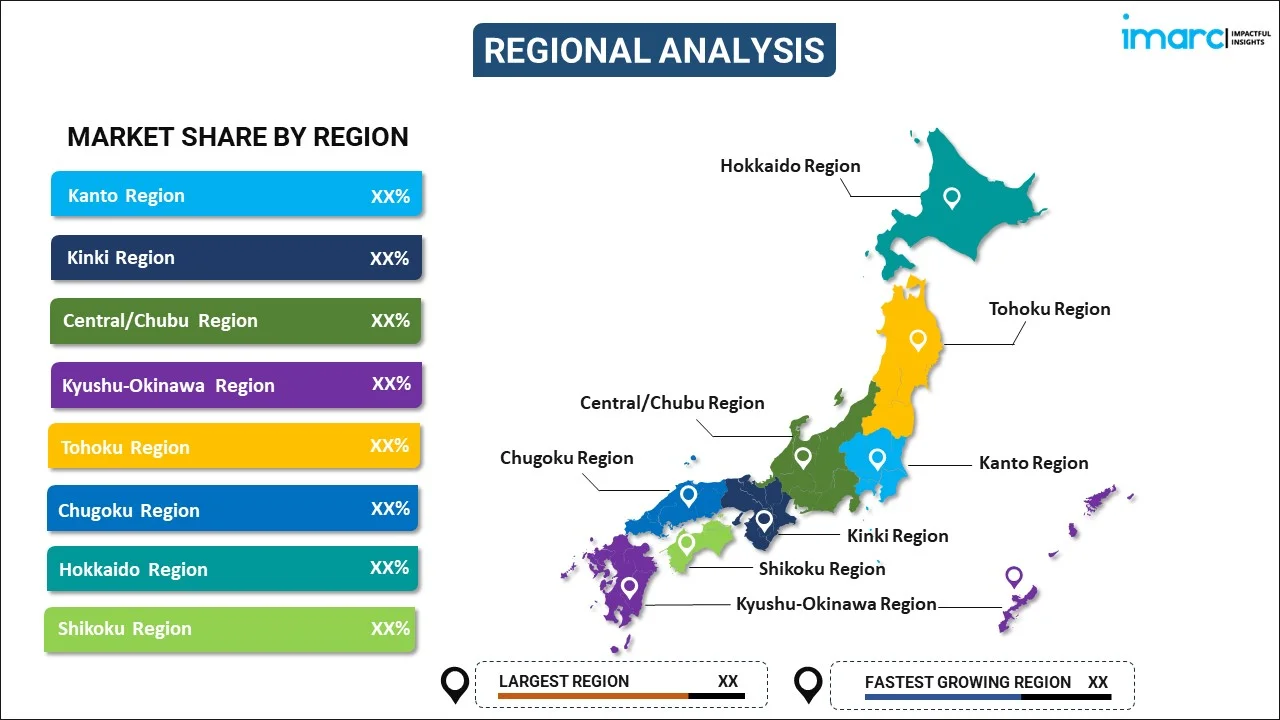
Japan Precious Metals Market Report by Metal Type (Gold, Silver, Platinum, Palladium, and Others), Application (Jewelry, Investment, Electricals, Automotive, Chemicals, and Others), and Region 2025-2033
Market Overview:
The Japan precious metals market size reached USD 13.0 Billion in 2024. Looking forward, IMARC Group expects the market to reach USD 21.1 Billion by 2033, exhibiting a growth rate (CAGR) of 5.6% during 2025-2033. The growing awareness among individuals about using green products, favorable government initiatives, increased consumption of luxury goods among the masses, and rising application in commercial places represent some of the key factors driving the market.
|
Report Attribute
|
Key Statistics
|
|---|---|
|
Base Year
|
2024 |
|
Forecast Years
|
2025-2033
|
|
Historical Years
|
2019-2024
|
| Market Size in 2024 | USD 13.0 Billion |
| Market Forecast in 2033 | USD 21.1 Billion |
| Market Growth Rate (2025-2033) | 5.6% |
Precious metals are specific highly valuable elements that are naturally occurring and are known for their rarity, durability, and high economic value. These metals are highly conductive and resistant to corrosion and oxidation, making them invaluable in various sectors such as electronics, jewelry, coinage, and dentistry. Their excellent thermal and electrical conductivity, along with their high luster and density, make them ideal for use in many industrial applications. In addition to this, they are also ideal options for use in harsh environments or where durability and longevity are necessary, such as in industrial applications, catalytic converters in vehicles, and dental fillings. Precious metals also serve as a trusted and reliable store of value, often used as a hedge against economic instability or inflation, which contributes to their high demand. They also serve as a form of currency, resulting in the advent of precious metals-based exchange-traded funds (ETFs) and digital trading platforms.
Japan Precious Metals Market Trends/Drivers:
The market in Japan is primarily driven by the augmenting product demand in the rapidly expanding automotive sector, particularly in vehicles of premium brands. This can be attributed to the rising adoption of platinum and palladium in catalytic converters of the vehicles, which are subjected to high-quality production. In line with this, the rapid utilization of precious metals such as gold, silver, and palladium for manufacturing various high-tech components in the electronics industry is providing an impetus to the market. Moreover, the widespread cultural significance of various precious metals such as gold and silver in Japan, is providing a boost to their demand in jewelry and investment sectors. In addition to this, favorable initiatives taken by the Japanese government promoting renewable energy sources are augmenting the demand for silver in photovoltaic cells used in solar panels. Also, the shifting consumer preference for responsibly sourced metals is propelling a large number of Japanese businesses towards more sustainable mining practices, thereby fueling the market. The market is further driven by the extensive e-waste recycling programs across the country focusing on recovering valuable metals from discarded electronics, which is acting as a significant growth inducing factor for the market. Furthermore, the rising inflation and geopolitical tensions are resulting in a higher product utilization as a hedge against currency fluctuations and attracting more investors to the market. Some of the other factors contributing to the market include rapid urbanization, increased consumption of luxury goods among the masses, inflating disposable income levels, and extensive research and development (R&D) activities.
Japan Precious Metals Industry Segmentation:
IMARC Group provides an analysis of the key trends in each segment of the Japan precious metals market report, along with forecasts at the country level for 2025-2033. Our report has categorized the market based on metal type and application.
Breakup by Metal Type:

- Gold
- Silver
- Platinum
- Palladium
- Others
The report has provided a detailed breakup and analysis of the market based on the metal type. This includes gold, silver, platinum, palladium, and others.
Breakup by Application:
- Jewelry
- Investment
- Electricals
- Automotive
- Chemicals
- Others
A detailed breakup and analysis of the market based on the application has also been provided in the report. This includes jewelry, investment, electricals, automotive, chemicals, and others.
Breakup by Region:

- Kanto Region
- Kinki Region
- Central/ Chubu Region
- Kyushu-Okinawa Region
- Tohoku Region
- Chugoku Region
- Hokkaido Region
- Shikoku Region
The report has also provided a comprehensive analysis of all the major regional markets, which include Kanto Region, Kinki Region, Central/ Chubu Region, Kyushu-Okinawa Region, Tohoku Region, Chugoku Region, Hokkaido Region, and Shikoku Region.
Competitive Landscape:
The report has also provided a comprehensive analysis of the competitive landscape in the Japan precious metals market. Competitive analysis such as market structure, key player positioning, top winning strategies, competitive dashboard, and company evaluation quadrant has been covered in the report. Also, detailed profiles of all major companies have been provided.
Japan Precious Metals Market Report Scope:
| Report Features | Details |
|---|---|
| Base Year of the Analysis | 2024 |
| Historical Period | 2019-2024 |
| Forecast Period | 2025-2033 |
| Units | Billion USD |
| Scope of the Report | Exploration of Historical and Forecast Trends, Industry Catalysts and Challenges, Segment-Wise Historical and Predictive Market Assessment:
|
| Metal Types Covered | Gold, Silver, Platinum, Palladium, Others |
| Applications Covered | Jewelry, Investment, Electricals, Automotive, Chemicals, Others |
| Regions Covered | Kanto Region, Kinki Region, Central/ Chubu Region, Kyushu-Okinawa Region, Tohoku Region, Chugoku Region, Hokkaido Region, Shikoku Region |
| Customization Scope | 10% Free Customization |
| Post-Sale Analyst Support | 10-12 Weeks |
| Delivery Format | PDF and Excel through Email (We can also provide the editable version of the report in PPT/Word format on special request) |
Key Questions Answered in This Report:
- How has the Japan precious metals market performed so far and how will it perform in the coming years?
- What has been the impact of COVID-19 on the Japan precious metals market?
- What is the breakup of the Japan precious metals market on the basis of metal type?
- What is the breakup of the Japan precious metals market on the basis of application?
- What are the various stages in the value chain of the Japan precious metals market?
- What are the key driving factors and challenges in the Japan precious metals market?
- What is the structure of the Japan precious metals market and who are the key players?
- What is the degree of competition in the Japan precious metals market?
Key Benefits for Stakeholders:
- IMARC’s report offers a comprehensive quantitative analysis of various market segments, historical and current market trends, market forecasts, and dynamics of the Japan precious metals market from 2019-2033.
- The research study provides the latest information on the market drivers, challenges, and opportunities in the Japan precious metals market.
- Porter's five forces analysis assist stakeholders in assessing the impact of new entrants, competitive rivalry, supplier power, buyer power, and the threat of substitution. It helps stakeholders to analyze the level of competition within the Japan precious metals industry and its attractiveness.
- Competitive landscape allows stakeholders to understand their competitive environment and provides an insight into the current positions of key players in the market.
Need more help?
- Speak to our experienced analysts for insights on the current market scenarios.
- Include additional segments and countries to customize the report as per your requirement.
- Gain an unparalleled competitive advantage in your domain by understanding how to utilize the report and positively impacting your operations and revenue.
- For further assistance, please connect with our analysts.
 Inquire Before Buying
Inquire Before Buying
 Speak to an Analyst
Speak to an Analyst
 Request Brochure
Request Brochure
 Request Customization
Request Customization




.webp)




.webp)












